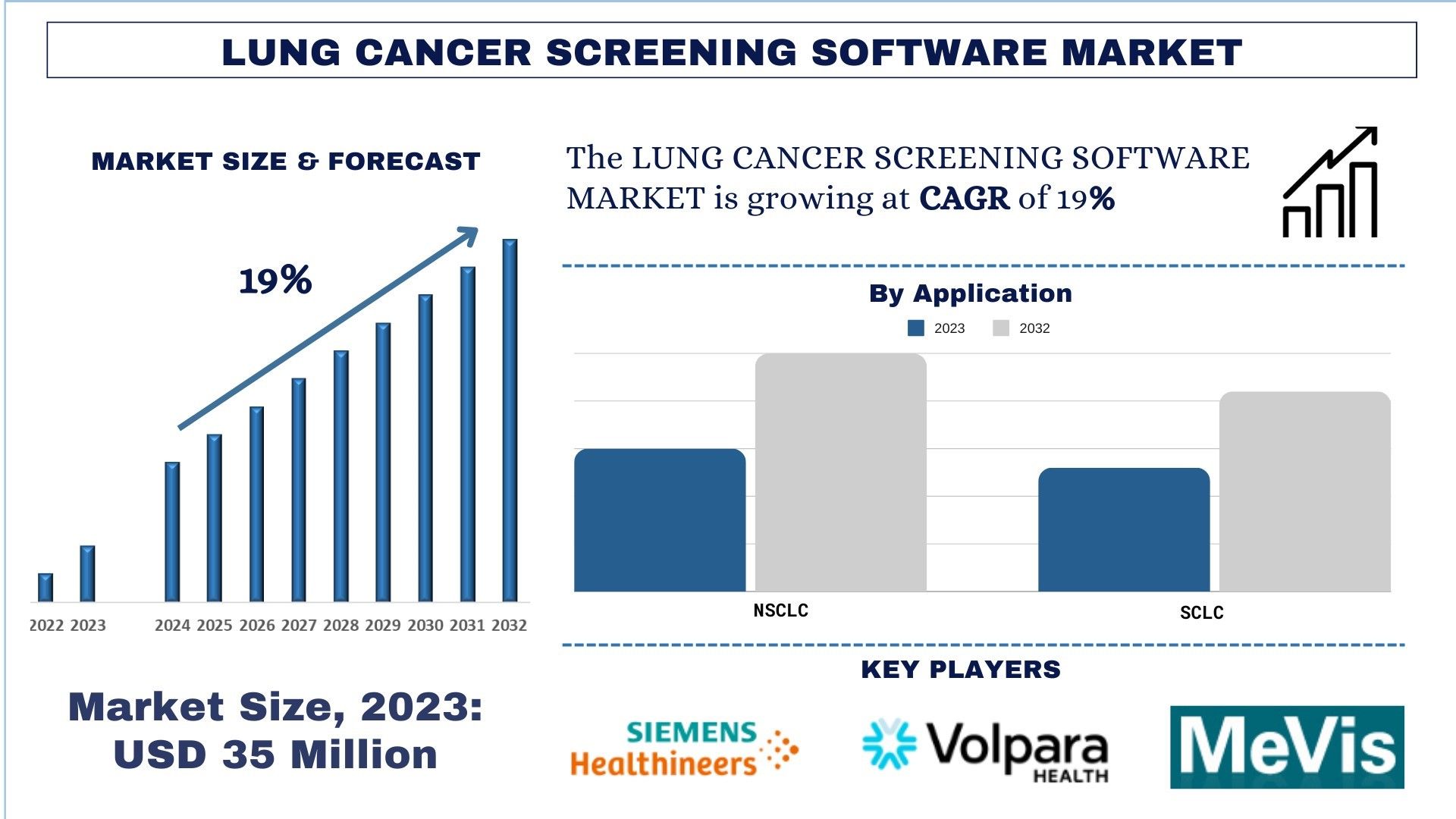- Home
- About Us
- Industry
- Services
- Reading
- Contact Us
Lung Cancer Screening Software Market: Current Analysis and Forecast (2024-2032)
Emphasis on Type (Cloud Based, On-Premises, and Web-Based); Application [Non-Small Cell Lung Cancer (NSCLC) and Small Cell Lung Cancer (SCLC)], End-Users (Oncology centers, Hospitals, and Others); and Region/Country
Lung Cancer Screening Software Market Size & Forecast
The Lung Cancer Screening Software Market was valued at approximately USD 35 Million in 2023 and is expected to grow at a strong CAGR of around 19% during the forecast period (2024-2032) owing to the rising trend of AI-based screening.
Lung Cancer Screening Software Market Analysis
The lung cancer screening software market is witnessing significant growth, driven by the increasing incidence of lung cancer, advancements in imaging technology, supportive government initiatives, and the integration of artificial intelligence (AI). These software solutions enhance the early detection and diagnosis of lung cancer, ultimately improving patient outcomes and survival rates. The market can be segmented into oncology centers, hospitals, and others, with each segment contributing uniquely to the market dynamics. Rising incidence of lung cancer is acting as one of the major drivers for the market and lung cancer remains one of the most common and deadly cancers worldwide.
For instance, as per the data of World Health Organization (WHO), lung cancer accounted for 2.21 million new cases and 1.8 million deaths in 2020. This high incidence necessitates effective screening programs to detect cancer early and initiate timely treatment.
For instance, as per the data of Lung Cancer Research Foundation, about 238,340 people were diagnosed with lung cancer in US during the year 2023.
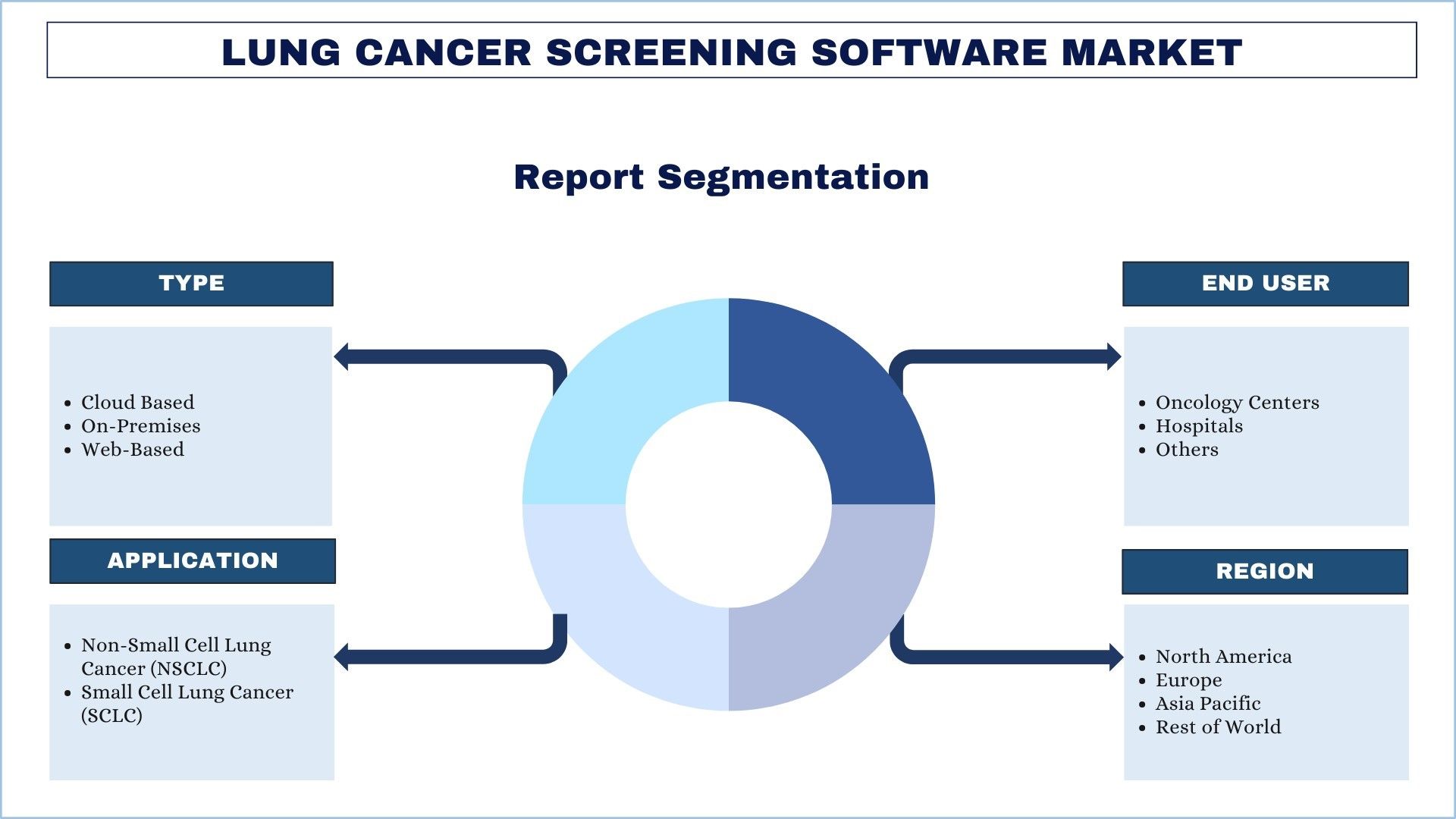
Lung Cancer Screening Software Market Trends
This section discusses the key market trends that are influencing the various segments of the Lung Cancer Screening Software Market as identified by our team of research experts.
Integration of Artificial Intelligence and Machine Learning
The lung cancer screening software market is evolving rapidly, driven by technological advancements and increasing awareness about the importance of early detection. The merging of artificial intelligence (AI) and machine learning (ML) is one of the biggest developments in the lung cancer screening software industry. Lung cancer diagnosis accuracy and efficiency are being revolutionized by these technologies. AI systems are capable of quickly analyzing large amounts of complex imaging data to find trends and abnormalities that could point to the existence of cancer. This skill lessens the possibility of false positives and negatives, resulting in diagnoses that are more trustworthy.
North America is Expected to Grow with Significant CAGR During Forecast Period
The Lung Cancer Screening Software market in North America has experienced significant growth in recent years, driven by various factors. North America, particularly the U.S., represents one of the largest markets for Lung Cancer Screening Software globally. One of the primary drivers of the Lung Cancer Screening Software market in North America is the rising cases of lung cancer and high demand for advanced solutions. Further, North America has a well-established regulatory framework that ensures the safety and efficacy of advanced screening technologies.
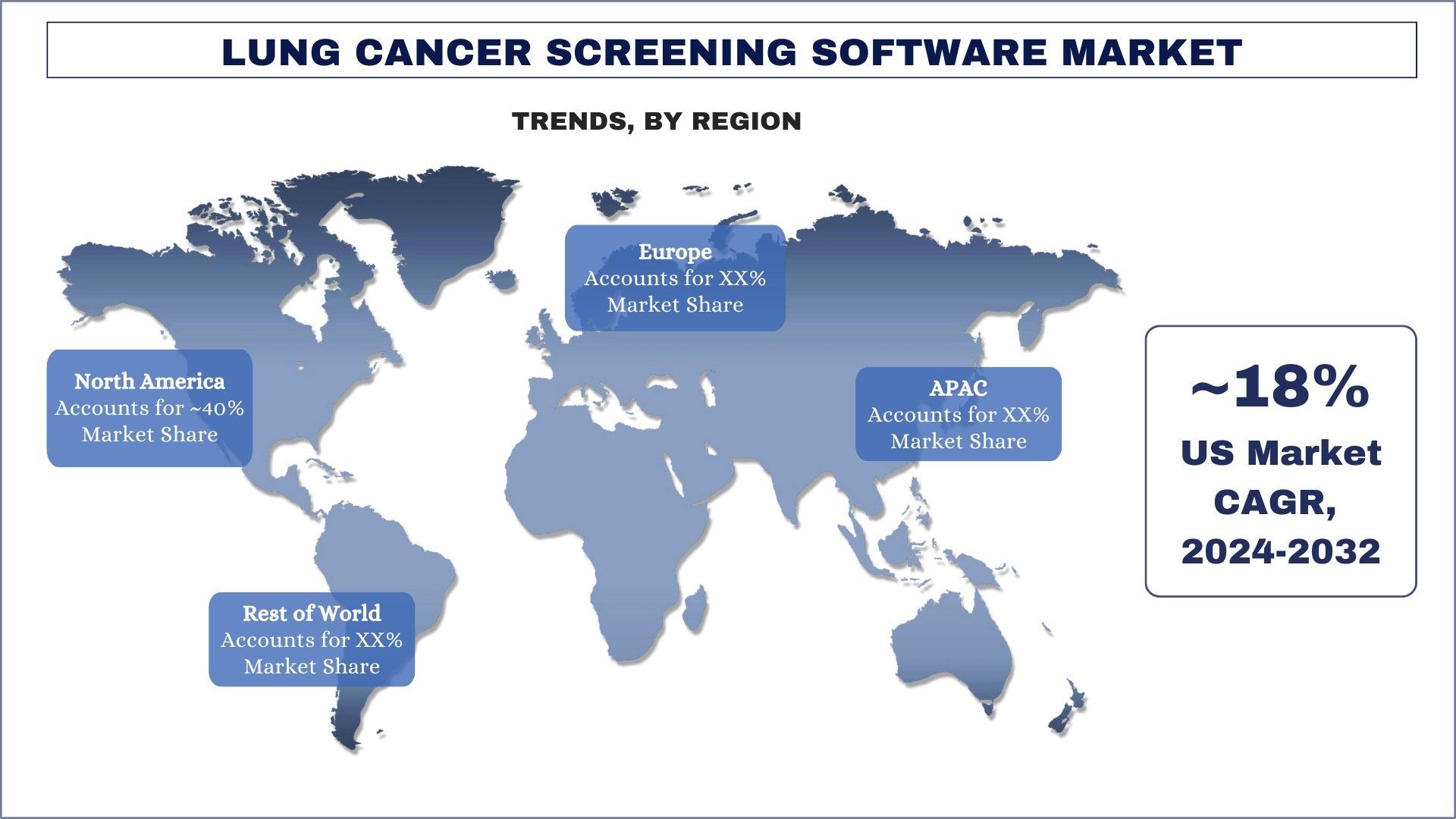
Lung Cancer Screening Software Industry Overview
The Lung Cancer Screening Software market is competitive, with the presence of several global and international market players. The key players are adopting different growth strategies to enhance their market presence, such as partnerships, agreements, collaborations, new product launches, geographical expansions, and mergers and acquisitions. Some of the major players operating in the market are Siemens Healthcare GmbH, Volpara Health Limited, Magview, MeVis Medical Solutions AG, CANON MEDICAL SYSTEMS EUROPE B.V., Epic Systems Corporation, Medtronic, F. HoffmannLa Roche Ltd, FUJIFILM Holdings Corporation, and Median Technologies.
Lung Cancer Screening Software Market Report Coverage
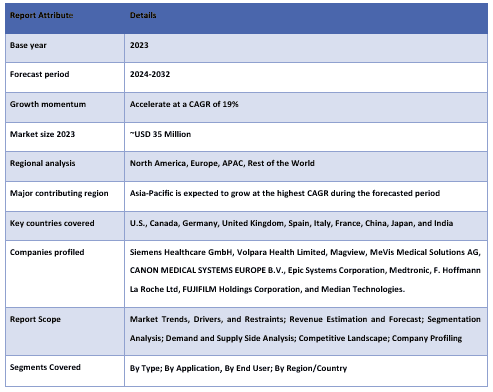
Reasons to buy this report:
- The study includes market sizing and forecasting analysis validated by authenticated key industry experts.
- The report presents a quick review of overall industry performance at one glance.
- The report covers an in-depth analysis of prominent industry peers with a primary focus on key business financials, product portfolios, expansion strategies, and recent developments.
- Detailed examination of drivers, restraints, key trends, and opportunities prevailing in the industry.
- The study comprehensively covers the market across different segments.
- Deep dive regional level analysis of the industry.
Customization Options:
The global Lung Cancer Screening Software market can further be customized as per the requirement or any other market segment. Besides this, UMI understands that you may have your own business needs, hence feel free to connect with us to get a report that completely suits your requirements.
Table of Content
Research Methodology for the Lung Cancer Screening Software Market Analysis (2024-2032)
Analyzing the historical market, estimating the current market, and forecasting the future market of the global Lung Cancer Screening Software market were the three major steps undertaken to create and analyze the adoption of Lung Cancer Screening Software in major regions globally. Exhaustive secondary research was conducted to collect the historical market numbers and estimate the current market size. Secondly, to validate these insights, numerous findings and assumptions were taken into consideration. Moreover, exhaustive primary interviews were also conducted, with industry experts across the value chain of the global Lung Cancer Screening Software market. Post assumption and validation of market numbers through primary interviews, we employed a top-down/bottom-up approach to forecasting the complete market size. Thereafter, market breakdown and data triangulation methods were adopted to estimate and analyze the market size of segments and sub-segments of the industry pertains to. Detailed methodology is explained below:
Analysis of Historical Market Size
Step 1: In-Depth Study of Secondary Sources:
A detailed secondary study was conducted to obtain the historical market size of the Lung Cancer Screening Software market through company internal sources such as annual reports & financial statements, performance presentations, press releases, etc., and external sources including journals, news & articles, government publications, competitor publications, sector reports, third-party database, and other credible publications.
Step 2: Market Segmentation:
After obtaining the historical market size of the Lung Cancer Screening Software market, we conducted a detailed secondary analysis to gather historical market insights and share for different segments & sub-segments for major regions. Major segments are included in the report as type, application, end-user, and regions. Further country-level analyses were conducted to evaluate the overall adoption of testing models in that region.
Step 3: Factor Analysis:
After acquiring the historical market size of different segments and sub-segments, we conducted a detailed factor analysis to estimate the current market size of the Lung Cancer Screening Software market. Further, we conducted factor analysis using dependent and independent variables such as type, application, end-user, and regions of the Lung Cancer Screening Software market. A thorough analysis was conducted for demand and supply-side scenarios considering top partnerships, mergers and acquisitions, business expansion, and product launches in the Lung Cancer Screening Software market sector across the globe.
Current Market Size Estimate & Forecast
Current Market Sizing: Based on actionable insights from the above 3 steps, we arrived at the current market size, key players in the global Lung Cancer Screening Software market, and market shares of the segments. All the required percentage shares split, and market breakdowns were determined using the above-mentioned secondary approach and were verified through primary interviews.
Estimation & Forecasting: For market estimation and forecast, weights were assigned to different factors including drivers & trends, restraints, and opportunities available for the stakeholders. After analyzing these factors, relevant forecasting techniques i.e., the top-down/bottom-up approach were applied to arrive at the market forecast for 2032 for different segments and sub-segments across the major markets globally. The research methodology adopted to estimate the market size encompasses:
- The industry’s market size, in terms of revenue (USD) and the adoption rate of the Lung Cancer Screening Software market across the major markets domestically
- All percentage shares, splits, and breakdowns of market segments and sub-segments
- Key players in the global Lung Cancer Screening Software market in terms of products offered. Also, the growth strategies adopted by these players to compete in the fast-growing market.
Market Size and Share Validation
Primary Research: In-depth interviews were conducted with the Key Opinion Leaders (KOLs) including Top Level Executives (CXO/VPs, Sales Head, Marketing Head, Operational Head, Regional Head, Country Head, etc.) across major regions. Primary research findings were then summarized, and statistical analysis was performed to prove the stated hypothesis. Inputs from primary research were consolidated with secondary findings, hence turning information into actionable insights.
Split of Primary Participants in Different Regions
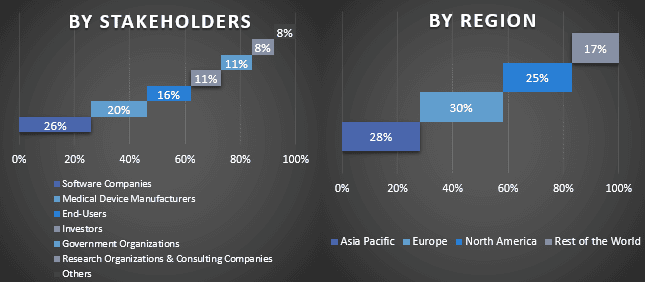
Market Engineering
The data triangulation technique was employed to complete the overall market estimation and to arrive at precise statistical numbers for each segment and sub-segment of the global Lung Cancer Screening Software market. Data was split into several segments & sub-segments post studying various parameters and trends in the areas of the Type, application, end-user, and regions in the global Lung Cancer Screening Software market.
The main objective of the Global Lung Cancer Screening Software Market Study
The current & future market trends of the global Lung Cancer Screening Software market were pinpointed in the study. Investors can gain strategic insights to base their discretion for investments on the qualitative and quantitative analysis performed in the study. Current and future market trends determined the overall attractiveness of the market at a regional level, providing a platform for the industrial participant to exploit the untapped market to benefit from a first-mover advantage. Other quantitative goals of the studies include:
- Analyze the current and forecast market size of the Lung Cancer Screening Software market in terms of value (USD). Also, analyze the current and forecast market size of different segments and sub-segments.
- Segments in the study include areas of the Type, application, end-user, and regions.
- Define and analyze the regulatory framework for the Lung Cancer Screening Software
- Analyze the value chain involved with the presence of various intermediaries, along with analyzing customer and competitor behaviors of the industry.
- Analyze the current and forecast market size of the Lung Cancer Screening Software market for the major region.
- Major countries of regions studied in the report include Asia Pacific, Europe, North America, and the Rest of the World
- Company profiles of the Lung Cancer Screening Software market and the growth strategies adopted by the market players to sustain in the fast-growing market.
- Deep dive regional level analysis of the industry
Frequently Asked Questions FAQs
Q1: What is the Lung Cancer Screening Software market's current market size and growth potential?
Q2: What are the driving factors for the growth of the Lung Cancer Screening Software market?
Q3: Which segment has the largest share of the Lung Cancer Screening Software market by type?
Q4: What are the emerging technologies and trends in the Lung Cancer Screening Software market?
Q5: Which region will dominate the Lung Cancer Screening Software market?
Related Reports
Customers who bought this item also bought

